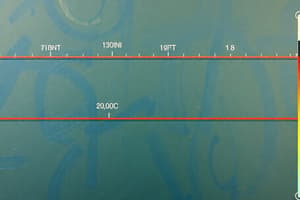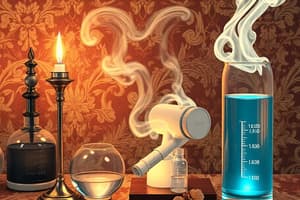Podcast
Questions and Answers
What is the primary unit for pressure in gas laws?
What is the primary unit for pressure in gas laws?
- Atmosphere (correct)
- Pascal
- Bar
- Torr
Boyle's Law states that volume and temperature are inversely proportional.
Boyle's Law states that volume and temperature are inversely proportional.
False (B)
What is the value of standard temperature in Kelvin?
What is the value of standard temperature in Kelvin?
273.15
At STP, 1 mole of any gas occupies __________ liters.
At STP, 1 mole of any gas occupies __________ liters.
Which gas law describes the relationship between pressure and temperature?
Which gas law describes the relationship between pressure and temperature?
Match the gas law with its relationship:
Match the gas law with its relationship:
Gases have a low density compared to liquids and solids.
Gases have a low density compared to liquids and solids.
What is the relationship between pressure and volume in Boyle's Law?
What is the relationship between pressure and volume in Boyle's Law?
Flashcards
Pressure
Pressure
The force exerted per unit area. It is often measured in atmospheres (atm), where 1 atm is the weight of air per unit area at sea level.
STP (Standard Temperature and Pressure)
STP (Standard Temperature and Pressure)
A set of conditions where the temperature is 0°C (273.15 K) and the pressure is 1 atm.
Temperature
Temperature
A measure of the average kinetic energy of particles in a substance.
Boyle's Law
Boyle's Law
A law that states that the pressure and volume of a gas are inversely proportional at constant temperature.
Signup and view all the flashcards
Charles' Law
Charles' Law
A law that states that the volume of a gas is directly proportional to its absolute temperature at constant pressure.
Signup and view all the flashcards
Gay-Lussac's Law
Gay-Lussac's Law
A law that states that the pressure of a gas is directly proportional to its absolute temperature at constant volume.
Signup and view all the flashcards
Avogadro's Law
Avogadro's Law
A law that states that equal volumes of gases at the same temperature and pressure contain the same number of molecules.
Signup and view all the flashcards
Avogadro's Hypothesis
Avogadro's Hypothesis
Describes the relationship between the volume of a gas and the number of moles of the gas at constant temperature and pressure.
Signup and view all the flashcardsStudy Notes
Gases
- Gases expand spontaneously
- Gases are highly compressible
- Gases have low density
Pressure
- Pressure is force exerted on an area
- Common unit: atm (atmosphere) - weight of air per unit area
- Other units: 760 torr = 760 mmHg = 101.325 kPa = 1.013 bar
- Pressure is caused by gas particles hitting the container's surface
STP
- Standard Temperature and Pressure
- 0°C and 1 atm
- Used for calculating gas properties
Temperature
- Temperature measures average kinetic energy of gas particles
- Use Kelvin scale in gas law calculations (K = °C + 273.15)
Basic Gas Laws
Boyle's Law
- Relates pressure and volume
- Pressure and volume are inversely proportional (P1V1 = P2V2)
Charles's Law
- Relates volume and temperature
- Volume and temperature are directly proportional (V1/T1 = V2/T2)
Gay-Lussac's Law
- Relates pressure and temperature
- Pressure and temperature are directly proportional (P1/T1 = P2/T2)
Avogadro's Law
- Relates moles and volume
- Volume and moles are directly proportional (V1/n1 = V2/n2) at constant temperature and pressure. (At STP, 1 mole of any ideal gas occupies 22.4 liters.)
Studying That Suits You
Use AI to generate personalized quizzes and flashcards to suit your learning preferences.




